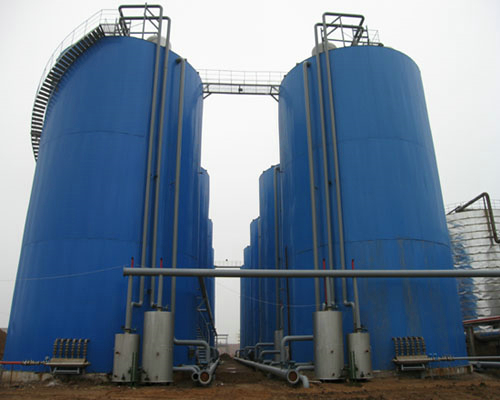
Wastewater Anaerobic biological treatment is an important technology in environmental engineering and energy engineering. It is one of the powerful treatments for organic wastewater. In the past, it was used for sewage sludge, organic waste and some high-concentration organic wastewater , The use of ordinary digestion tank in the form of buildings, due to the existence of long hydraulic retention time, low organic load shortcomings, a long time to limit its application in wastewater treatment
basic introduction
Wastewater Anaerobic biological treatment is an important technology in environmental engineering and energy engineering. It is one of the powerful treatments for organic wastewater. In the past, it was used for sewage sludge, organic waste and some high-concentration organic wastewater , The use of ordinary digestion tank in the form of buildings, due to the existence of long hydraulic retention time, low organic load shortcomings, a long time to limit its application in wastewater treatment, since the 20th century, 70 years, the world's energy shortage Outstanding, can produce energy waste water anaerobic technology has been valued, research and practice deepening, the development of a variety of new technology and equipment, a substantial increase in the anaerobic reactor activated sludge holding capacity, so that processing time Shortening, efficiency, anaerobic biochemical method and aerobic biochemical method has the following advantages:
Seven advantages:
Wide range of applications
?Low energy consumption
?High load
?Less residual sludge
?Nitrogen, phosphorus nutrient requirements less
Anaerobic treatment process has a certain bactericidal effect, you can kill the waste water and sewage in the parasites, viruses, etc.
Anaerobic activated sludge can be stored for a long period of time, and anaerobic reactors can be run in a seasonal or intermittent manner.
Fundamental
Basic definition: Wastewater Anaerobic biological treatment refers to the process of converting various complex organic molecules in wastewater into methane, carbon dioxide and other substances through the action of anaerobic organisms (including anoxic organisms) in the absence of molecular oxygen, Anaerobic digestion. Wastewater Anaerobic biological treatment is in the absence of oxygen under the conditions of the use of anaerobic microorganisms degradation of organic matter in the sewage to achieve the purification method. In anaerobic conditions, the anaerobic bacteria in sewage to carbohydrates, protein, fat and other organic matter decomposition of organic acids, and then under the action of methane bacteria, the further fermentation of methane, carbon dioxide and hydrogen, so that the sewage was purified The It is one of the good treatments for domestic sewage sludge, high concentration organic wastewater and manure.
Anaerobic digestion is divided into three stages:
The first stage: Hydrolysis acidification stage
The second stage: hydrogen production of acetic acid stage
The third stage: the methane production stage
working principle
Overview: Anaerobic composite bed reactor is actually anaerobic biofilter AF and upflow anaerobic sludge reactor UASB combined, so called UBF reactor. The lower part of the anaerobic composite bed reactor is a sludge suspension layer and the upper part is filled with a filler. It can be seen that the thickness of the packed bed of the upflow type anaerobic biofilter is appropriately reduced and a certain space is left between the pool water distribution system and the packing layer so that the particulate sludge in the suspended state can accumulate , And thus constitute a UASB treatment process. When the effluent is passed through the suspended sludge layer and the filler layer, the organic matter will be contacted with the microbes on the sludge sludge and the filler biofilm and broken down. Working principle: After adjusting the pH and temperature of the wastewater first into the reactor at the bottom of the mixing area, and with the external circulation from the mud mixture of mixed into the granular sludge into the expansion bed area for COD biochemical degradation, where the COD volume load Very high, most of the influent COD is degraded here, resulting in a large amount of biogas. As the biogas bubble formation process of the liquid to do the role of the expansion of the role of gas, so that biogas, sludge and water mixture rose, after the degradation of the filler area, the mixture to the top of the reactor three-phase separator, biogas Where it is separated from the mud and then exported to the treatment system. The muddy water mixture descends along the fender to the mixing zone at the bottom of the reactor and enters the sludge expansion bed again after the influent is mixed thoroughly to form a so-called internal circulation. According to the different influent COD load and the different structure of the reactor, the external circulation can reach 0.5-10 times of the influent flow. After the waste bed treatment of waste water in addition to part of the cycle, the remaining sewage continues to rise, the sewage into the filler area for residual COD degradation and biogas production process to improve and ensure the water quality. Since most of the COD has been degraded, the COD load in the packed zone is low and the gas production is also small. The biogas produced here is also collected by a three-phase separator, through the trachea derivation treatment system. After the waste water treated by the filler area is treated by the three-phase separator, the supernatant is discharged through the effluent area and the granular sludge is returned to the sludge bed.











